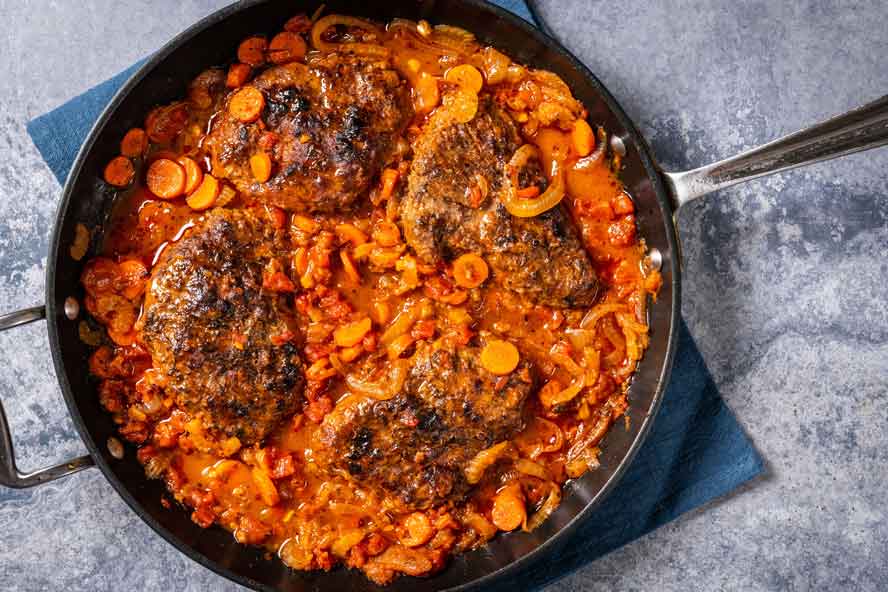 Laura Chase de Formigny for The Washington Post
Laura Chase de Formigny for The Washington Post
According to data released by the Bureau of Economic Analysis, the price of meat and poultry was up 11.4% in October compared to a year ago, and the price of beef and veal was up 20.1% for that same time frame.
For those looking to still eat beef without breaking the bank, it's time to say so long to the short ribs, and hello to tri-tip and top round.
On a recent stroll through the meat aisle of my local grocery store, the cheaper cuts of beef I saw included chuck steak, "beef for stew," cube steak, beef shoulder London Broil, and top round minute steak. They were all less than $10 per pound, but the issues with these more affordable cuts are that they are either full of sinew and tendon, or are extremely lean. However, with the proper know-how, they can become just as tender and delicious as - if not more so than - filet mignon.
Here's what you need to know:
• One way to deal with tough muscle fibers is to simply break them apart. The cube steaks sold at the grocery store have been run through a mechanical tenderizer, a process called "Swissing." At home, you can pound steaks into thin pieces and break down connective tissue with a meat mallet. Or, if your want to cut the fibers without altering the shape, you can use a bladed meat tenderizer that pierces, but doesn't flatten it.
• Another option is to go with a dry brine, which means to salt the meat well in advance of cooking. As I wrote about with turkey, dry-brining beef similarly helps to tenderize the meat (and makes it more flavorful, too). Per J. Kenji López-Alt in Serious Eats, you should salt your steaks at least 40 minutes before cooking and up to overnight for the best results.
• Some recipe publications have also touted the idea of using baking soda to tenderize beef. To do this, you either briefly submerge smaller pieces of beef in a solution of baking soda and water or rub larger pieces with baking soda and let them rest in the refrigerator for a few hours before rinsing and proceeding with cooking. However, in testing this method with some top round minute steaks, I noticed an off taste with the steaks rubbed with baking soda compared to those without. Even when I thought I rinsed them very thoroughly, I and others were not happy with the flavor. Regardless of how tender a piece of meat is, taste is paramount.
• Last but not least are marinades. "The two most popular types of marinades are acidic (made with citrus, vinegar, or wine) and enzymatic (made with ingredients such as pineapple and papaya)," Shirley Corriher wrote in Fine Cooking. "Highly acidic marinades can actually toughen food, while enzymatic marinades can turn the surface of the food to mush." As such, most acidic marinades are used only briefly and primarily for flavor instead of as a tenderizing agent, and if you want to go the route of an enzymatic marinade, be sure to set a timer and wipe it off after a short period of time.
The best way to cook each cut depends on its structure.
• For leaner cuts (think top round and eye of round): Cook them rare and slice them thin, like roast beef. It can also help to add fat, which can be done by barding (wrapping meat in fat, before cooking) or basting (Hello margarine!)
• For fattier cuts (think chuck and brisket): Low and slow cooking breaks down the sinew and tendons, which leaves "the unparalleled moist richness we love so much in barbecue and braises," Matt Rodbard and Daniel Holzman wrote for Taste.
• Another option for the technologically-inclined is to use a sous vide machine. "Tough steaks turn into brilliant eating if cooked low enough and long enough," Brendan McGinley wrote in Thrillist. "An immersion circulator (the actual name for what people just call 'the sous vide machine') holds them at the perfect temperature and moisture until cartilage, fat, and stronger muscle have all broken down."
• But the easiest and perhaps most important step in dealing with beef meant for slicing is to do so thinly and against the grain when serving. What makes meat tough is the long muscle fibers - a.k.a. "the grain" - so simply cut them to make them shorter and you automatically have more tender meat.


 Contact The Editor
Contact The Editor
 Articles By This Author
Articles By This Author